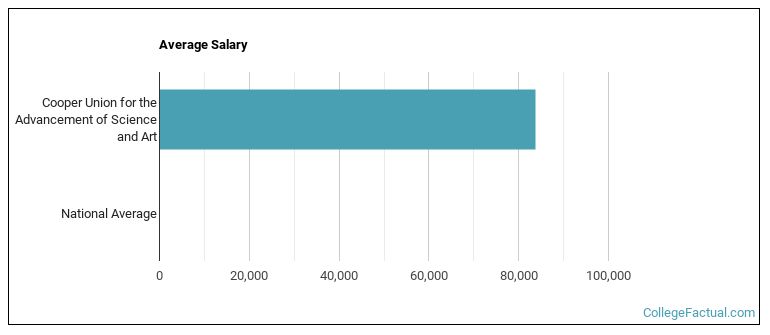 by our College Data Analytics Team
by our College Data Analytics TeamExplore the best ranked schools for the programs you are most interested in.
Cooper Union was not ranked in College Factual's 2025 Best Overall Colleges report. This could be for a number of reasons, including lack of data.
See all of the rankings for Cooper Union for the Advancement of Science and Art.
Cooper Union for the Advancement of Science and Art has a very low acceptance rate of 22%, making it one of the most selective out of all the colleges and universities in the nation. It's probably a good idea to apply to other schools in addition to Cooper Union just in case you don't make the cut.
About 49% of students accepted to Cooper Union submitted their SAT scores. When looking at the 25th through the 75th percentile, SAT Evidence-Based Reading and Writing scores ranged between 670 and 740. Math scores were between 720 and 790.
Learn more about Cooper Union for the Advancement of Science and Art admissions.
The student to faculty ratio is often used to measure the number of teaching resources that a college or university offers its students. The national average for this metric is 15 to 1, but at Cooper Union it is much better at 9 to 1. That's good news for students who want to interact more on a personal level with their teachers.
Another measure that is often used to estimate how much access students will have to their professors is how many faculty members are full-time. The idea here is that part-time faculty tend to spend less time on campus, so they may not be as available to students as full-timers.
The full-time faculty percentage at Cooper Union for the Advancement of Science and Art is 29%. This is lower than the national average of 47%.
Cooper Union for the Advancement of Science and Art has a freshmen retention rate of 93%. That's a good sign that full-time students like the school and their professors enough to want to stick around for another year. It's also a sign that the admissions team did a good job in choosing applicants who were a good fit for the school.
The on-time graduation rate for someone pursuing a bachelor's degree is typically four years. This rate at Cooper Union for first-time, full-time students is 66%, which is better than the national average of 33.3%.
During the 2017-2018 academic year, there were 806 undergraduates at Cooper Union with 802 being full-time and 4 being part-time.
| $0-30 K | $30K-48K | $48-75 | $75-110K | $110K + |
|---|---|---|---|---|
| $4,074 | $5,004 | $7,712 | $17,998 | $30,143 |
The net price is calculated by adding tuition, room, board and other costs and subtracting financial aid.Note that the net price is typically less than the published for a school. For more information on the sticker price of Cooper Union, see our tuition and fees and room and board pages.
It's not uncommon for college students to take out loans to pay for school. In fact, almost 66% of students nationwide depend at least partially on loans. At Cooper Union, approximately 20% of students took out student loans averaging $8,310 a year. That adds up to $33,240 over four years for those students.
Get more details about paying for Cooper Union for the Advancement of Science and Art.

See which majors at Cooper Union for the Advancement of Science and Art make the most money.
Get more details about the location of Cooper Union for the Advancement of Science and Art.

Contact details for Cooper Union are given below.
| Contact Details | |
|---|---|
| Address: | 7 East 7Th Street, New York, NY 10003-7120 |
| Phone: | 212-353-4100 |
| Website: | https://www.cooper.edu/ |
| Most Popular Majors | Bachelor’s Degrees | Average Salary of Graduates |
|---|---|---|
| Fine & Studio Arts | 62 | $16,678 |
| Electrical Engineering | 52 | NA |
| Civil Engineering | 29 | NA |
| Chemical Engineering | 27 | NA |
| Mechanical Engineering | 22 | NA |
| General Architecture | 20 | NA |
| Drafting & Design Engineering Technology | 6 | NA |
| General Engineering | 4 | NA |
If you’re considering Cooper Union for the Advancement of Science and Art, here are some more schools you may be interested in knowing more about.
Curious on how these schools stack up against Cooper Union? Pit them head to head with College Combat, our free interactive tool that lets you compare college on the features that matter most to you!
Footnotes
*The racial-ethnic minorities count is calculated by taking the total number of students and subtracting white students, international students, and students whose race/ethnicity was unknown. This number is then divided by the total number of students at the school to obtain the racial-ethnic minorities percentage.
References
More about our data sources and methodologies.